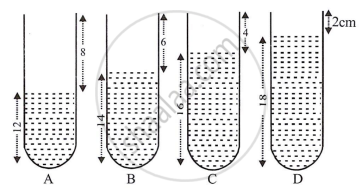Advertisements
Advertisements
प्रश्न
In following figure shows A, B , C and D represent test tube each of height 20 cm which are filled with water up to heights of 12 cm, 14 cm, 16cm and 18cm respectively. If a vibrating tuning fork is placed over the mouth if test tube D, a loud sound is heard.

- Describe the observations with the tubes A, B and C when the vibrating tuning fork is placed over the mouth of these tubes.
- Give the reason for your observation in each case.
- State the principle illustrated by the above experiment.
उत्तर
- No loud sound is heard with the tubes A and C, but a loud sound is heard with the tube B.

- While tubes A and C do not experience resonance with their air columns, tube B does. The air column length in tube D is 20 – 18 = 2 cm, while in tube B it is 20 – 14 = 6 cm, which is three times the length in tube D. Consequently, the frequency of vibrations in both tubes is identical. Contrarily, air column vibrations in tubes A and C do not have the same frequency as those in tube B.
- Resonance happens when the air column vibration frequency is exactly the same as the tuning fork vibration frequency.
APPEARS IN
संबंधित प्रश्न
What are mechanical waves?
How does the medium affect the amplitude of free/natural vibrations of a body?
When a troop crosses a suspension bridge, the soldiers are asked to break steps. Explain the reason.
Differentiate between the following:
Free and forced vibrations.
What do you mean by resonance? When does resonance occur?
The rearview mirror of a motorbike starts vibrating violently at some particular speed of the motorbike, what could be done to stop the violent vibrations.
Explain why are soldiers asked to walk out of step while crossing bridges?
Explain a person walking past a railway line, in the middle of night hears a ringing sound along with the sound of his footsteps.
